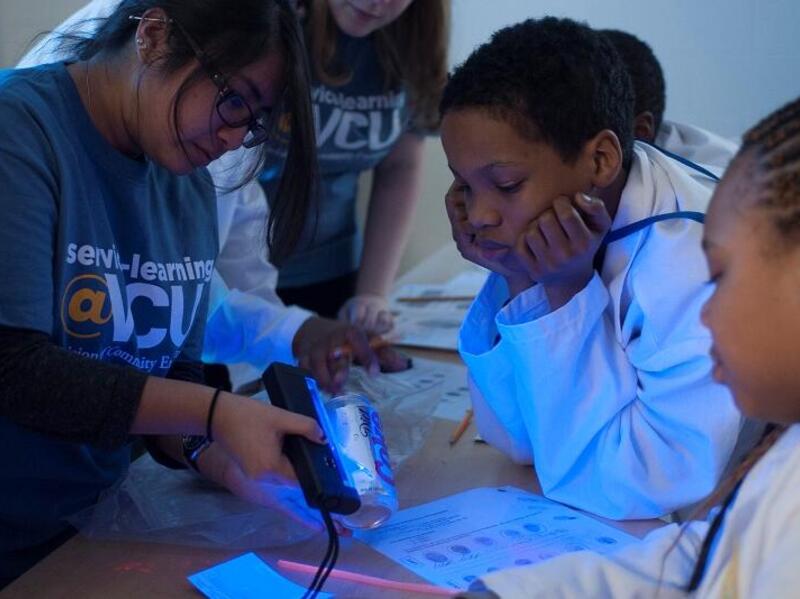
Dec. 4, 2015
Forensic science students investigate reconstructed crime scene with 3-D technology
Share this story
In a parking lot off Floyd Avenue on a recent afternoon, a team of forensic science majors from Virginia Commonwealth University examined a reconstructed murder scene.
Their class assignment? Document every detail of the site with state-of-the-art 3-D scanning technology.
Next to a pickup truck, the students had positioned a life-size foam mannequin. Poking through its head was a metal rod simulating the trajectory of a bullet. A few yards away, a Leica 3-D laser scanning device sat atop a tripod, taking precise measurements of the murder scene and the surrounding parking lot.

“We’re trying to figure out if the entry wound was in the front of the victim’s head or the back of the victim’s head,” said senior forensic science major Kierra Johnson.
The students’ project was part of a new course focused on 3-D crime scene scanning technology offered this semester in the Department of Forensic Science in the College of Humanities and Sciences.
“We offer a basic crime scene investigation class and an advanced crime scene investigation class. Originally I was going to use the laser scanner in the advanced class but the class is just crammed with stuff already, so I thought it’d be nice to offer a separate course on this very specific topic of 3-D laser scanning crime scenes and the class filled up,” said Marilyn Miller, Ed.D., an associate professor of forensic science.
Before joining VCU, Miller worked as a supervisor and forensic scientist for law enforcement agencies in North Carolina, Pennsylvania and Florida. She also serves as an expert witness on forensic science and crime scene reconstruction, and has testified more than 450 times in county, state and federal courts of law.
In a typical crime scene investigation, it is standard procedure to document the scene with note-taking, photography, video and sketches with precise measurements and scale drawings.
Over the past five years, however, 3-D laser scanners have increasingly been adopted by crime scene investigators, as the devices provide precise measurements and can produce 3-D animated “fly-throughs” of the scene, which can be helpful to visualize the crime.
“It’s basically the newest technology for documenting crime scenes,” Miller said. “It’s become the industry’s gold standard.”
We always talk about ‘Make it real’ here at VCU. Well, this is a real piece of equipment that is out there, and these students are getting to use it.
In Virginia, only six law enforcement agencies, including Virginia State Police, have started using 3-D laser scanning of crime scenes, Miller said, but the trend is growing nationally.
“We always talk about ‘Make it real’ here at VCU. Well, this is a real piece of equipment that is out there, and these students are getting to use it,” she said. “It’s not a cheap piece of equipment. It’s almost $60,000. So the students are getting to use it, and they are becoming very proficient with it.”
“This is cutting-edge technology that our students are using,” she added. “They’re not just reading about it.”
For the assignment, Miller worked with VCU’s Department of Parking and Transportation to find a spot where the students could re-create the crime scene, which is based on a real case on which Miller consulted.
“This was a case in which I was asked to do a reconstruction of a crime scene as to which would be more likely, given the evidence we have, was this a shooting from the front or from the behind?” she said. “So the students are creating a visual representation of both scenarios.”
Bianca Spaulding, a senior forensic science major with a concentration in biology, said she and her classmates were excited to learn how to operate such as sophisticated crime scene investigation tool.
“To be able to have access to this technology, especially as an undergrad, is kind of cool. Because it gives me a skill set that a lot of other people might not have,” said Spaulding, as she set up the scanner in the parking lot. “If I’m looking for a job, this could potentially help me get into different programs, or I could start doing research on this if I wanted to. It’s really beneficial, especially as this continues to become more widespread.”
Kaitlyn Lytle, a senior forensic science major, said the 3-D scanning process can take a while — the first time they tried it, it took close to five hours — but she’s glad to be getting hands-on experience with the technology.
“It’s believed that this is where it’s going to go in the future,” she said. “It gives really precise details of the evidence and everything. A [crime] scene can get a little messed up when you have all the [investigators] around, so this is a more surefire way that you get everything that you need to get.”

Subscribe to the weekly VCU News email newsletter at http://newsletter.news.vcu.edu/ and receive a selection of stories, videos, photos, news clips and event listings in your inbox every Thursday.
Subscribe to VCU News
Subscribe to VCU News at newsletter.vcu.edu and receive a selection of stories, videos, photos, news clips and event listings in your inbox.






